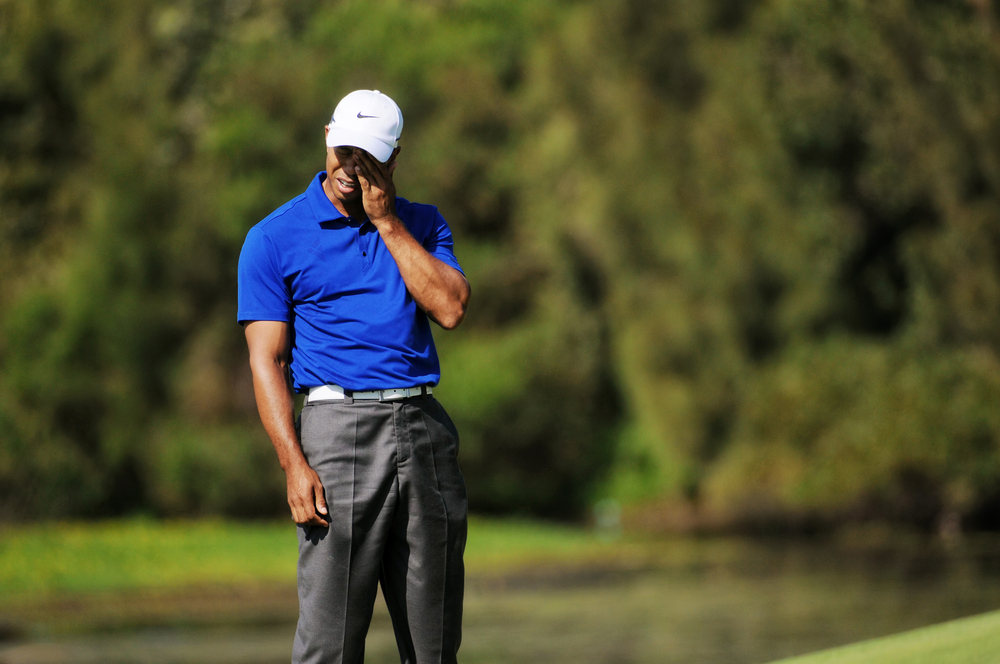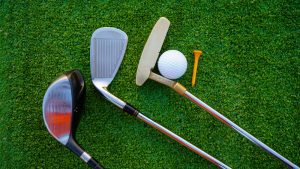Every golfer has experienced that sinking feeling of swinging and completely missing the ball.
The short answer is yes—a whiff counts as a stroke if you intended to hit the ball, and it will add one to your score with no additional penalty.
Keep reading for the complete breakdown of when whiffs count, when they don't, and how this rule applies in different situations on the course.
Understanding What Constitutes a Stroke According to Official Golf Rules
The USGA defines a stroke as “the forward movement of your club made to strike the ball.
This definition might seem straightforward, but it reveals something important: you don't actually need to make contact with the ball for it to count as a stroke.
Intent becomes the deciding factor in whether your swing counts toward your score.
When you make that forward club movement with the purpose of hitting the ball, you've committed to a stroke regardless of the outcome.
This means your embarrassing whiff on the first tee counts just as much as a perfect drive down the fairway.
The key difference lies between attempting to hit the ball versus accidental contact.
If you're taking practice swings and accidentally nudge the ball, that doesn't count as a stroke because you had no intention of making contact.
However, if you step up to your ball, take your stance, and swing with the goal of sending it toward the target, you've made a stroke whether you connect or not.
The official definition focuses on club movement rather than ball contact for good reason.
Golf would become much more complicated if strokes only counted when you made contact.
You'd have situations where players could argue about glancing blows, barely perceptible contact, or whether the ball actually moved.
The current rule eliminates these gray areas and keeps scoring consistent.
This rule applies universally across all golf organizations and tournaments, from your local municipal course to the Masters Tournament.
The PGA Tour, European Tour, and amateur competitions all follow the same standard, which means you can expect consistent application whether you're playing a casual round with friends or competing in your club championship.
When Your Whiff Counts as a Stroke (And Adds to Your Score)
When you step up to your ball and make a full swing attempt with clear intention to hit it, that counts as a stroke even if you miss completely.
This applies whether you're 200 yards out in the fairway or standing over a simple putt—the location doesn't matter, only your intent.
Tee box whiffs create a unique situation.
If you swing and miss on the tee and the ball stays put, you've used one stroke but can choose to keep the ball teed up for your next shot or play it from the ground.
Either way, you're now hitting your second shot after that costly air swing.
The rule kicks in whenever you make forward club movement with clear intention to strike the ball.
This covers scenarios ranging from nervous first-tee jitters to concentration lapses during pressure situations.
Poor timing often leads to whiffs when you're rushing your swing or when external distractions throw off your rhythm, but these still count as strokes because you intended to make contact.
Professional golf provides stark reminders of this rule's impact.
Collin Morikawa's whiff during a PGA Tour event added a crucial stroke to his score, ultimately contributing to his playoff loss.
Even at the highest level, intent matters more than execution when it comes to stroke counting.
Here's what makes the rule particularly unforgiving: addressing the ball creates the expectation of intentional contact.
Once you take your stance and position your club behind the ball, any forward swing motion signals your intent to hit it.
You can't claim the whiff was accidental after going through your full pre-shot routine and setup.
The bottom line remains simple—if you meant to hit the ball when you swung, count the stroke and move on to your next shot.
Situations Where a Whiff Won't Count Against Your Score
You can avoid adding a stroke to your score when you deliberately change your swing to miss the ball.
The key word here is “deliberately”—you must consciously decide to avoid contact during your swing motion.
Checked swings offer your best escape route.
If you start your downswing but intentionally abort before impact, you haven't committed to striking the ball.
This happens when you suddenly realize you're using the wrong club or notice a hazard you missed during setup.
The critical factor is stopping your swing with purpose, not simply missing due to poor technique.
Last-second distractions can save you a stroke if you react properly.
When a cart drives by, someone talks during your backswing, or you notice movement in your peripheral vision, you can deliberately swing over the ball to avoid contact.
The difference between this and a regular whiff lies in your conscious decision to miss rather than accidentally failing to connect.
Zach Johnson's incident at the 2019 Masters perfectly illustrates accidental contact during practice swings.
He was taking practice swings near his ball when he accidentally made contact and moved it.
Since he had no intention of hitting the ball during what he considered a practice motion, it didn't count as a stroke.
However, officials did require him to replace the ball to its original position.
The rule protects you when you deliberately stop the clubhead before reaching the ball or consciously attempt to avoid ball contact during your downswing.
These situations require split-second decision-making, but they demonstrate clear intent to not strike the ball.
Understanding this distinction matters: stopping a swing shows intent to avoid contact, while missing intentionally after committing to hit the ball still counts as a stroke.
You cannot decide mid-swing to “miss on purpose” and expect it not to count—that decision must come before you commit to striking the ball.
Real-World Examples and Professional Golf Incidents

Professional golf provides the most dramatic examples of whiff rules in action.
Collin Morikawa's whiff during a PGA Tour playoff became a costly lesson in how intent matters more than skill level.
Despite being one of the world's best players, his clear intention to hit the ball meant the stroke counted, ultimately contributing to his playoff loss and costing him a tournament victory.
Zach Johnson's 2019 Masters incident offers the perfect contrast.
While taking practice swings near his ball, Johnson accidentally made contact and moved it.
Since he had no intention of hitting the ball during what he considered practice motion, officials ruled it wasn't a stroke.
However, they required him to replace the ball to its original position under the rules.
Tour professionals handle whiffs with immediate acceptance and proper scoring.
When these situations arise during tournament play, players don't argue or seek exceptions—they count the stroke and continue play.
This professional approach stems from understanding that arguing intent after the fact rarely succeeds and that maintaining pace of play takes priority.
Recreational golfers frequently misunderstand the rule in several ways:
- Claiming “practice swing” after clearly addressing the ball
- Not counting whiffs during casual rounds, then struggling with proper scoring in tournaments
- Believing that embarrassment somehow exempts them from stroke counting
Intent becomes difficult to determine when players hover over the ball for extended periods or make multiple false starts.
Video evidence and referee decisions in professional tournaments focus on observable behavior: did the player address the ball, take their stance, and make forward club movement toward the ball's position?
The most telling indicator remains the player's setup routine.
Once someone goes through their normal pre-shot process and positions themselves to hit the ball, referees assume intentional contact was the goal, regardless of the outcome.
Scoring Rules and What Happens After You Whiff
Good news: whiffing carries no additional penalty beyond counting as one stroke.
Unlike hitting into water hazards or going out of bounds, your air swing simply adds one to your score without any extra punishment strokes.
Tee box whiffs come with a unique advantage.
After missing your tee shot, you can choose to keep the ball teed up for your next attempt or play it from the ground.
This decision is entirely yours, and many golfers prefer staying teed since it offers a cleaner strike opportunity for their second shot.
Your handicap calculation treats whiffs exactly like any other stroke.
The USGA Handicap System doesn't differentiate between a 300-yard drive and a complete miss—both count as one stroke toward your score.
This means failing to count whiffs during casual rounds artificially lowers your handicap and creates an unfair advantage in competition.
Scorecard marking stays straightforward: simply add one stroke to your running total for that hole.
You don't need special notation or symbols—a whiff gets recorded the same way as any other stroke.
Some golfers mark a small “W” next to the hole number as a personal reminder, but official scoring requires only the total stroke count.
Tournament play demands strict adherence to whiff counting, while casual rounds often see relaxed enforcement.
However, this inconsistency creates problems when recreational golfers enter competitions and struggle with proper scoring habits.
The rules apply equally whether you're playing for a green jacket or a weekend Nassau.
Understanding the difference between stroke counting and penalty strokes prevents confusion.
Penalty strokes get added for rule violations like hitting out of bounds or taking relief from hazards.
Whiffs represent actual strokes you attempted, not penalties for breaking rules.
This distinction matters for both scoring accuracy and understanding your true playing ability.
Practical Application and Common Misconceptions
Casual players often ignore whiff counting because they view golf rules as flexible during friendly rounds.
This creates a dangerous habit where “mulligans” and “breakfast balls” extend to not counting obvious strokes.
The problem intensifies when these players enter tournaments or post scores for handicap purposes without adjusting their scoring mindset.
Consistent application starts with one simple question: “Did you try to hit the ball?”
If the answer is yes, count the stroke regardless of the outcome.
This approach eliminates debates about technique, embarrassment, or whether the miss was “close enough” to count.
Teaching playing partners requires tactful conversation, especially when someone habitually skips counting whiffs.
Focus on handicap accuracy and tournament preparation rather than criticizing their casual approach.
You might say, “Hey, let's practice proper scoring today since we're both playing in the club championship next month.”
The handicap implications of ignoring whiffs are significant.
Players who consistently skip counting misses artificially lower their handicap index, which creates unfair advantages in competitions and prevents accurate course rating feedback.
Your handicap should reflect your actual scoring ability, including the occasional air swing.
Here's the practical reality: building good golf etiquette around honest scoring benefits everyone in your group.
When one player maintains strict scoring standards, others typically follow suit.
This creates better practice for tournament play and more accurate handicap posting across your regular foursome.
Common misconceptions include believing that:
- Whiffs during practice rounds “don't matter”
- Embarrassing shots shouldn't count toward handicap
- Tournament rules differ fundamentally from casual play rules
The truth is simpler: golf rules apply universally, and developing consistent scoring habits during casual play prepares you for competitive situations where proper scoring becomes mandatory.
Conclusion
The whiff rule comes down to one simple principle: if you intended to hit the ball when you swung, it counts as a stroke regardless of whether you made contact.
This rule applies consistently across all levels of golf, from weekend rounds to professional tournaments, with no additional penalties beyond adding one stroke to your score.
Master this fundamental scoring rule, and you'll avoid confusion while building the honest scoring habits that make you a better golfer and playing partner.







